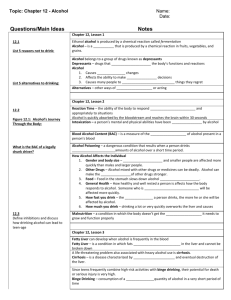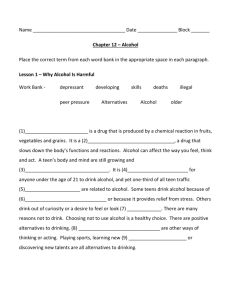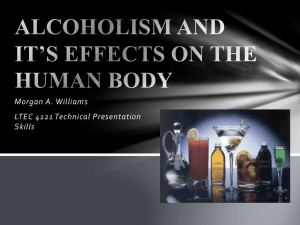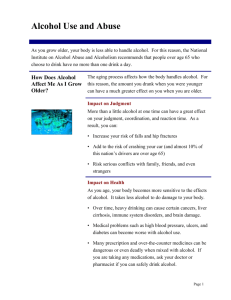Alcohol - WordPress.com
advertisement
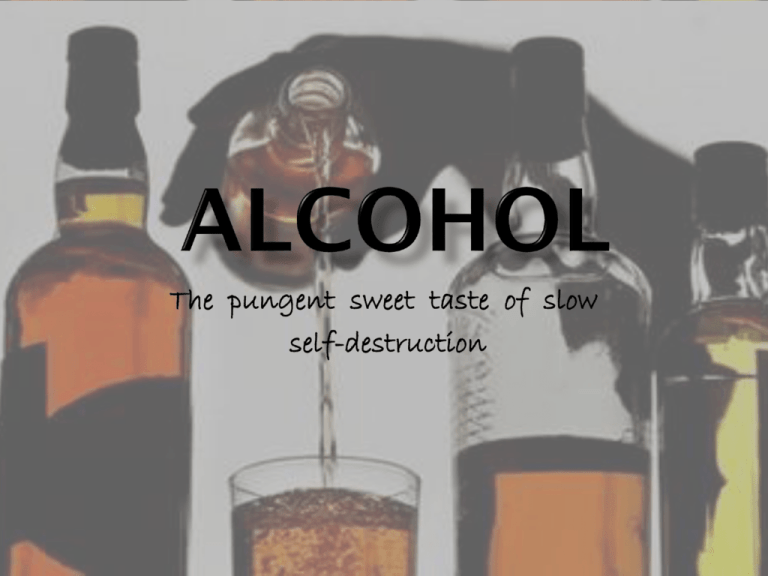
The pungent sweet taste of slow self-destruction Alcohol is an organic compound in which the hydroxyl functional group (-OH) is bound to a carbon atom. It has a long history of several uses worldwide and is found in alcoholic beverages sold to adults, as fuel, and also has many scientific, medical, and industrial uses. Some consumers of some commercially prepared products may view alcohol as an undesirable ingredient, particularly in products intended for children. Alcoholic beverages have been produced and consumed by People drink to socialize, celebrate, and relax. Alcohol often has a strong effect on people – and throughout history, we’ve struggled to understand and manage alcohol’s power. Why does alcohol cause us to act and feel differently? How much is too much? Why do some people become addicted while others don’t? These matters have constantly been looked into and along with them there also were many other questions about alcohol. Here’s what is known so far: Alcohol’s effects vary from person to person, depending on a variety of factors, including: How much you drink; How often you drink; Your age; Your health status; Your family history. Alcoholism is a broad term for problems with alcohol, and is generally used to mean compulsive and uncontrolled consumption of alcoholic beverages, usually to the detriment of the drinker's health, personal relationships, and social standing. It is medically considered a disease, specifically an addictive illness. In psychiatry several other terms have been used, specifically "alcohol abuse", "alcohol dependence," and "alcohol use disorder" which have slightly different definitions. Alcohol misuse has the potential to damage almost every organ in the body, including the brain. The cumulative toxic effects of chronic alcohol abuse can cause both medical and psychiatric problems. A complex mixture of genetic and environmental factors influences the risk of the development of alcoholism. Genes that influence the metabolism of alcohol also influence the risk of alcoholism, and may be indicated by a family history of alcoholism. One paper has found that alcohol use at an early age may influence the expression of genes which increase the risk of alcohol dependence. Individuals who have a genetic disposition to alcoholism are also more likely to begin drinking at an earlier age than average. Also, a younger age of onset of drinking is associated with an increased risk of the development of alcoholism, and about 40 percent of alcoholics will drink excessively by their late adolescence. It is not entirely clear whether this association is causal, and some researchers have been known to disagree with this view. Severe childhood trauma is also associated with a general increase in the risk of drug dependency. Lack of peer and family support is associated with an increased risk of alcoholism developing. Genetics and adolescence are associated with an increased sensitivity to the neurotoxic effects of chronic alcohol abuse. Cortical degeneration due to the neurotoxic effects increases impulsive behaviour, which may contribute to the development, persistence and severity of alcohol use disorders. There is evidence that with abstinence, there is a reversal of at least some of the alcohol induced central nervous system damage. WHILE DRINKING ALCOHOL IS ITSELF NOT NECESSARILY A PROBLEM – DRINKING TOO MUCH CAN CAUSE A RANGE OF CONSEQUENCES, AND INCREASE YOUR RISK FOR A VARIETY OF PROBLEMS. Alcohol enters your bloodstream as soon as you take your first sip. Alcohol’s immediate effects can appear within about 10 minutes. As you drink, you increase your blood alcohol concentration (BAC) level, which is the amount of alcohol present in your bloodstream. The higher your BAC, the more impaired you become by alcohol’s effects. Reduced inhibitions; Slurred speech; Motor impairment Confusion; Memory problems; Concentration problems; Coma; Breathing problems; Car crashes and other accidents; Risky behavior; Violent behavior; Suicide and homicide; Death. Drinking too much – on a single occasion or over time – can take a serious toll on your health. Here’s how alcohol can affect your body: Cirrhosis. Pancreas: Alcohol causes the pancreas to produce toxic Brain: substances that can eventually lead to pancreatitis, a Alcohol interferes with the brain’s communication dangerous inflammation and swelling of the blood pathways, and can affect the way the brain looks and vessels in the pancreas that prevents proper digestion. works. These disruptions can change mood and behavior, and make it harder to think clearly and move Cancer: with coordination. Drinking too much alcohol can increase your risk of Heart: developing certain cancers, including cancers of the: Drinking a lot over a long time or too much on a Mouth; single occasion can damage the heart, causing Esophagus; problems including: Cardiomyopathy – Stretching and drooping of heart Throat; muscle; Liver; Arrhythmias – Irregular heart beat; Breast. Stroke; High blood pressure. Immune System: Drinking too much can also weaken your immune system, making your body a much easier target for Liver: Chronic drinkers are more liable to contract Heavy drinking takes a toll on the liver, and can lead todisease. diseases like pneumonia and tuberculosis than people a variety of problems and liver inflammations who do not drink too much. including: Drinking a lot on a single occasion slows your body’s Steatosis, or fatty liver; ability to ward off infections – even up to 24 hours after Alcoholic hepatitis; getting drunk. Fibrosis; The social problems arising from alcoholism are serious, caused by the pathological changes in the brain and the intoxicating effects of alcohol. Alcohol abuse is associated with an increased risk of committing criminal offences, including child abuse, domestic violence, rape, burglary and assault. Alcoholism is associated with loss of employment, which can lead to financial problems. Drinking at inappropriate times, and behavior caused by reduced judgment, can lead to legal consequences, such as criminal charges for drunk driving or public disorder, or civil penalties for tortious behavior, and may lead to a criminal sentence. An alcoholic's behavior and mental impairment, while drunk, can profoundly affect those surrounding them and lead to isolation from family and friends. This isolation can lead to marital conflict and divorce, or contribute to domestic violence. Alcoholism can also lead to child neglect, with subsequent lasting damage to the emotional development of the alcoholic's children. For this reason, children of alcoholic parents can develop a number of emotional problems. For example, they can become afraid of their parents, because of their unstable mood behaviors. In addition, they can develop considerable amount of shame over their inadequacy to liberate their parents from alcoholism. As a result of this failure, they develop wretched self-images, which can lead to depression. Moderate alcohol consumption, according to the Dietary Guidelines for Americans, is up to 1 drink per day for women and up to 2 drinks per day for men. Moderate alcohol consumption may also have beneficial effects on health. These include decreased risk for heart disease and mortality due to heart disease, decreased risk of ischemic stroke (in which the arteries to the brain become narrowed or blocked, resulting in reduced blood flow), and decreased risk of diabetes. In most Western countries where chronic diseases such as coronary heart disease (CHD), cancer, stroke, and diabetes are the primary causes of death, results from large epidemiological studies consistently show that alcohol reduces mortality, especially among middle-aged and older men and women—an association which is likely due to the protective effects of moderate alcohol consumption on CHD, diabetes, and ischemic stroke. It is estimated that 26,000 deaths were averted in 2005 because of reductions in heart disease, stroke, and diabetes from the benefits attributed to moderate alcohol consumption. Expanding our understanding of the relationship between moderate alcohol consumption and potential health benefits remains a challenge, and although there are positive effects, alcohol may not benefit everyone who drinks moderately. Although many people enjoy moderate drinking, defined as 1 drink per day for women or 2 for men, drinking too much can lead to an overdose. An overdose of alcohol occurs when a person has a blood alcohol content (or BAC) sufficient to produce impairments that increase the risk of harm. Overdoses can range in severity, from problems with balance and slurred speech to coma or even death. Underage drinkers may be at particular risk for alcohol overdose. Research shows that people under age 20 typically drink about 5 drinks at one time. Drinking such a large quantity of alcohol can overwhelm the body’s ability to break down and clear alcohol from the bloodstream. Critical Signs and Symptoms of Alcohol Poisoning: Mental confusion, stupor, coma, or inability to wake up; Vomiting; Seizures; Slow breathing (fewer than 8 breaths per minute); Irregular breathing (10 seconds or more between breaths); Hypothermia (low body temperature), bluish skin color, paleness. What should I do If I suspect someone has alcohol poisoning? Know the danger signals; Do not wait for someone to have all the symptoms; Be aware that a person who has passed out may die; If you suspect an alcohol overdose, call 911 for help; What can happen to someone with alcohol poisoning that goes untreated? Choking on his or her own vomit; Breathing that slows, becomes irregular, or stops; Heart that beats irregularly or stops; Hypothermia (low body temperature); Hypoglycemia (too little blood sugar), which leads to seizures; Untreated severe dehydration from vomiting, which can cause seizures, permanent brain damage, and death. At the hospital, medical staff will manage any breathing problems, administer fluids to combat dehydration and low blood sugar, and flush the drinker’s stomach to help clear the body of toxins. The best way to avoid an alcohol overdose is to drink responsibly if you choose to drink. Total recorded alcohol per capital consumption in litres of pure alcohol. Treatment of alcoholism takes several steps. Because of the medical problems that can be caused by withdrawal, alcohol detoxification should be carefully controlled and may involve medications such as benzodiazepines such as diazepam. People with alcoholism also sometimes have other addictions, including addictions to benzodiazepines, which may complicate this step. After detoxification, other support such as group therapy or self-help groups are used to help the person remain sober.Thombs (1999) states according to behavioural sciences alcoholism is described as a “maladaptive behaviour”. He explains this must not be confused with “misbehaviour”. Behavioural scientists explain that addicts have a behaviour pattern that may lead to destructive consequences for themselves, their families and society. This does not label addicts as bad or irresponsible. Compared with men, women are more sensitive to alcohol's harmful physical, cerebral, and mental effects.
